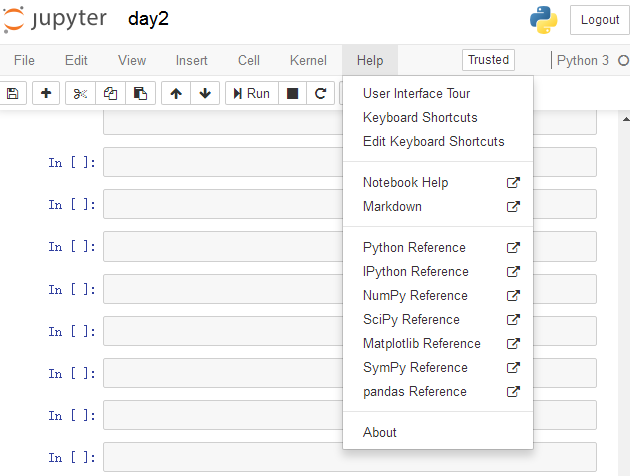Jupyter Notebook 快捷键和技巧
Jupyter Notebook 有两种键盘输入模式。
编辑模式,允许你往单元中键入代码或文本,这时的单元框线是绿色的。
命令模式,键盘输入运行程序命令;这时的单元框线是蓝色。
命令模式 (按键 Esc 开启)
- Enter : 转入编辑模式
- Shift-Enter : 运行本单元,选中下个单元
- Ctrl-Enter : 运行本单元
- Alt-Enter : 运行本单元,在其下插入新单元
- Y : 单元转入代码状态
- M :单元转入markdown状态
- R : 单元转入raw状态
- 1 : 设定 1 级标题
- 2 : 设定 2 级标题
- 3 : 设定 3 级标题
- 4 : 设定 4 级标题
- 5 : 设定 5 级标题
- 6 : 设定 6 级标题
- Up : 选中上方单元
- K : 选中上方单元
- Down : 选中下方单元
- J : 选中下方单元
- Shift-K : 扩大选中上方单元
- Shift-J : 扩大选中下方单元
- A : 在上方插入新单元
- B : 在下方插入新单元
- X : 剪切选中的单元
- C : 复制选中的单元
- Shift-V : 粘贴到上方单元
- V : 粘贴到下方单元
- Z : 恢复删除的最后一个单元
- D,D : 删除选中的单元
- Shift-M : 合并选中的单元
- Ctrl-S : 文件存盘
- S : 文件存盘
- L : 转换行号
- O : 转换输出
- Shift-O : 转换输出滚动
- Esc : 关闭页面
- Q : 关闭页面
- H : 显示快捷键帮助
- I,I : 中断Notebook内核
- 0,0 : 重启Notebook内核
- Shift : 忽略
- Shift-Space : 向上滚动
- Space : 向下滚动
编辑模式 ( Enter 键启动)
- Tab : 代码补全或缩进
- Shift-Tab : 提示
- Ctrl-] : 缩进
- Ctrl-[ : 解除缩进
- Ctrl-A : 全选
- Ctrl-Z : 复原
- Ctrl-Shift-Z : 再做
- Ctrl-Y : 再做
- Ctrl-Home : 跳到单元开头
- Ctrl-Up : 跳到单元开头
- Ctrl-End : 跳到单元末尾
- Ctrl-Down : 跳到单元末尾
- Ctrl-Left : 跳到左边一个字首
- Ctrl-Right : 跳到右边一个字首
- Ctrl-Backspace : 删除前面一个字
- Ctrl-Delete : 删除后面一个字
- Esc : 进入命令模式
- Ctrl-M : 进入命令模式
- Shift-Enter : 运行本单元,选中下一单元
- Ctrl-Enter : 运行本单元
- Alt-Enter : 运行本单元,在下面插入一单元
- Ctrl-Shift-- : 分割单元
- Ctrl-Shift-Subtract : 分割单元
- Ctrl-S : 文件存盘
- Shift : 忽略
- Up : 光标上移或转入上一单元
- Down :光标下移或转入下一单元
HELP可以帮助我们直接进入对应的官方文档

Keyboard Shortcuts 原文档
Command Mode (press Esc to enable)Edit Shortcuts
Edit Mode (press Enter to enable)
Jupyter Notebook 快捷键和技巧的更多相关文章
- jupyter notebook快捷键速查手册
jupyter notebook快捷键速查手册 Enter : 转入编辑模式 Shift-Enter : 运行本单元,选中下个单元 Ctrl-Enter : 运行本单元 Alt-Enter : 运行本 ...
- Jupyter Notebook 快捷键
Jupyter Notebook 快捷键 从命令模式进入编辑模式需按 Enter 键,从编辑模式切换到命令模式需按Esc 键. Jupyter Notebook 是一个交互式笔记本程序, 其有丰富的快 ...
- Jupyter Notebook 快捷键(基本)
Jupyter Notebook 快捷键 Jupyter Notebook 有两种键盘输入模式.编辑模式,允许你往单元中键入代码或文本:这时的单元框线是绿色的.命令模式,键盘输入运行程序命令:这时的单 ...
- Jupyter Notebook使用小技巧
在 C:\Windows\Fonts目录下找到Mircosoft YaHei UI字体,然后复制到[你的Python安装路径]/Lib/site-packages/matplotlib/mpl-dat ...
- jupyter notebook快捷键使用指南
Jupyter Notebook 是一个交互式笔记本程序, 其有丰富的快捷键来便捷的完成工作.Notebook 有两种键盘输入模式.即命令模式和编辑模式,这与 Vim 有些类似.在编辑模式下,可以往单 ...
- Jupyter Notebook 快捷键使用指南
因为使用Jupyter Notebook用鼠标选择菜单影响效率,遂将快捷命令记录于此 转自:http://blog.konghy.cn/2017/05/04/jupyter-notebook-hotk ...
- Jupyter Notebook快捷键总结
1. Jupyter Notebook有两种mode Enter:进入edit模式 Esc:进入command模式 2. Command命令快捷键: A:在上方增加一个cell B:在下方增加一个ce ...
- jupyter notebook快捷键使用的注意点
来源:https://zhidao.baidu.com/question/1800695798976401387.html 本文做进一步的阐释: 1.使行出现,但是光标要点击到有line空白区域 直接 ...
- Jupyter Notebook 介绍 安装和使用技巧
Jupyter Notebook介绍.安装及使用教程 原文链接:https://www.jianshu.com/p/91365f343585 目录一.什么是Jupyter Notebook? 1. 简 ...
随机推荐
- 小程序报错:request:fail错误(含https解决方案)(真机预览问题)
问题描述:域名已经备案,我全部都有,也在后台配置了,但是手机预览,还是请求失败, PC端是可以请求数据出来的 新版开发者工具增加了https检查功能:可使用此功能直接本地避开ssl协议版本检查,但是此 ...
- Hyper-V 替换 vmwp
要激活 Hyper-V 下的虚机 最简单的方法是用带证书的vmwp替换掉原来的 带证书的vmwp参见:http://bbs.pcbeta.com/viewthread-1408240-1-1.html ...
- .Net Core下发送WebRequest请求的两种方式
1.使用RestSharp.NetCore 2.使用WebApi请求方式
- 多线程外排序解决大数据排序问题2(最小堆并行k路归并)
转自:AIfred 事实证明外排序的效率主要依赖于磁盘,归并阶段采用K路归并可以显著减少IO量,最小堆并行k路归并,效率倍增. 二路归并的思路会导致非常多冗余的磁盘访问,两组两组合并确定的是当前的相对 ...
- net core体系-web应用程序-4net core2.0大白话带你入门-9asp.net core服务的生命周期
asp.net core服务的生命周期 Transient:每一次GetService都会创建一个新的实例 Scoped:在同一个Scope内只初始化一个实例 ,可以理解为( 每一个request ...
- websocket/dwebsocket 实现前后端的实时通信
1. 用bottle框架,自己写一个服务端实现: 转载 :http://www.linuxyw.com/813.html 功能:用websocket技术,在运维工具的浏览器上实时显示远程服务器上 ...
- 51Nod1317 相似字符串对 容斥原理 动态规划
原文链接https://www.cnblogs.com/zhouzhendong/p/51Nod1317.html 题目传送门 - 51Nod1317 题意 称一对字符串(A,B)是相似的,当且仅当满 ...
- 今天一起探讨shiro实现账户同一时刻session唯一
今天和同事在一起探讨shiro如何实现一个账户同一时刻只有一session存在的问题,下面小编把核心代码分享到博客园平台,需要的朋友参考下http://m.0834jl.com 今天遇到一个项目问题, ...
- django-admin 仿写stark组件action,filter筛选过滤,search查询
写在StandLi里面的方法都是通过ModelSubject这个类里面的stand_li方法,在它里面用StandLi这个类实例化出来一个对象,这个实例化出来的对象把数据传给前端HTML模板进行渲染, ...
- thinkphp验证器
验证器类:$validate=new \think\Validate($rule,$message,$field); 独立验证: //独立验证 $rule=[ 'name' => 'requir ...
